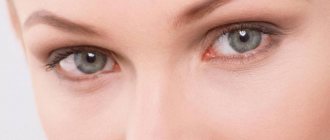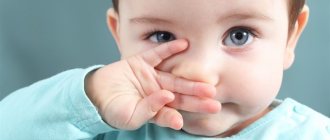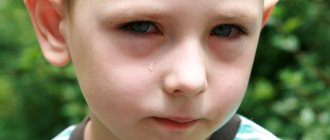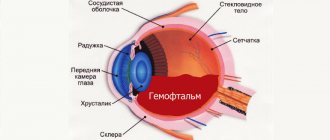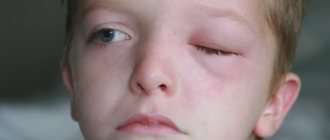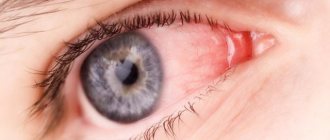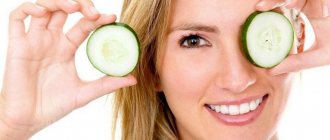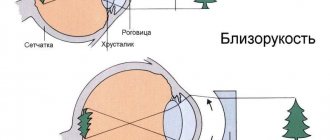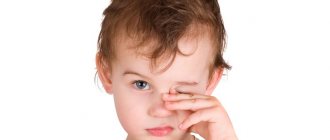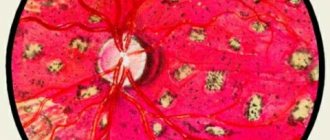Allergy in front of a child’s eyes refers to a common reaction of the body to an unfavorable environment. The organs of vision are characterized by a high degree of vulnerability and exposure to various aggressive factors. When an eye allergy occurs, there is a high risk of complications, so its treatment must be comprehensive and competent.
Swelling of the eyelids due to allergies: origin
The origin of allergic swelling of the eyelids depends on the specific cause.
External origin - when the mucous membrane of the eye comes into contact with an irritant. As a rule, swelling of only the eye in contact with the allergen is observed; the swelling does not spread widely. The reaction upon contact with an allergen occurs very quickly - from 5 minutes to half an hour.
Internal origin - here we are talking about a general reaction to an allergen that enters directly into the body as a result of food or airborne intoxication.
A harbinger of future swelling is often headache, weakness and loss of strength.
Symptoms
What the symptoms will be and what their intensity will be depends on various factors:
- state of the immune system; specific provoking factor;
- age;
- presence of concomitant diseases.
Manifestations of allergies under the eyes in children are almost the same as in adults. The only thing is that the child cannot always accurately and clearly explain what is bothering him.
Increased lacrimation is the first sign of the development of the disease
Read the article about what ailments Ciprofloxacin eye drops will help you get rid of.
Papillary conjunctivitis
It occurs as a result of wearing contact lenses and is an inflammatory disease that is localized on the mucous membrane of the eye. An allergic reaction is caused not only by microlenses, but also by the solution for their care. The manifestations of this disease include:
- the formation of small tubercles on the mucous membrane of the upper eyelid;
- redness of the sclera;
- edema.
Papillary conjunctivitis
It is important not to miss the first signs of the disease and start therapy in a timely manner - find out the possible causes of black spots before your eyes.
Eyelid dermatitis
Eyelid allergies in most cases occur after skin contact with an irritant, usually various skin care products and ointments. Insect bites can also cause the disease. The main signs of allergic dermatitis of the eyelids are:
- redness and itching of the skin around the eyes;
- swelling of the eyelids;
- the appearance of translucent bubbles filled with liquid;
- the skin becomes rough and rough;
- increased lacrimation.
Eyelid dermatitis
The symptoms and treatments for endocrine ophthalmopathy are described in detail here.
Dermatitis can also appear under the eyes
Acute inflammation of the tissues of the visual organ – endophthalmitis.
Keratoconjunctivitis
The allergic form of the disease is divided into 3 subtypes: phlyctenulosis, hay fever, and medicinal. The symptoms are similar:
- swelling of the eyelids;
- redness of the sclera;
- purulent discharge and increased lacrimation;
- photophobia.
Phlyctenulosis - occurs as a result of increased sensitivity of the body to various bacteria. They settle on the mucous membrane of the eye. After which nodules may form on the conjunctiva and cornea, developing into ulcers.
Hay fever - appears after contact with an irritant. Can be seasonal or year-round. In addition to the above symptoms, children with this allergy have itchy eyes and a runny nose.
Medicinal - manifests itself after exposure to a medication on the mucous membrane of the eye. It can occur in an acute form, i.e. within 24 hours after taking the medication, as well as in chronic cases - from several days to weeks. Most often, symptoms affect only the mucous membrane.
Medicines should be selected according to the age of the child.
Find out how effective and safe it is to use Oftocipro eye ointment here.
Photophobia is one of the signs of keratoconjunctivitis
Inflammation between the sclera and conjunctiva is episcleritis of the eye.
Source of allergy: diet
Children experience allergies to a wide variety of foods they eat. This is due both to the individual characteristics of a growing organism and to the properties of a number of products themselves that have varying degrees of allergenicity.
The most allergenic are citrus fruits, animal proteins and legumes, as well as chocolate, nuts and some grains.
If you have a food allergy, swelling of the eyelids is almost guaranteed. It is important to know: fermented milk products, cabbage, zucchini and broccoli, and turkey meat rarely provoke allergies.
Diagnosis and drug treatment
To make a correct diagnosis, a specialist will prescribe a general blood and urine test and examine the mucus that accumulates in the eyes.
In some cases, it is recommended to undergo an immunogram and take a biochemical blood test. When the main symptoms weaken, special tests are performed on the child’s skin: conjunctival, sublingual, nasal. The drug treatment of allergies involves therapy with local and tablet medications. For conjunctivitis, severe redness and severe itching, the specialist recommends treating the child with medications available in drops:
- azelastine;
- shark;
- allergy sufferer;
- lecrolin;
- supragila;
- tavegil;
- Opatanol.
The drugs dexamethasone (drops) and hydrocortisone (ointment) help reduce swelling and prevent the appearance of purulent discharge. When the mucous membrane of the eyeballs and eyelids becomes red, they resort to using Visine or Octylium. Treatment with these drugs should not be used for a long time.
Also, for allergies in the eyes of children, antihistamine tablets can be prescribed. Today, third generation drugs are recognized as the most effective and harmless for the child’s body. Many of them have virtually no side effects and do not cause drowsiness or lethargy. These include:
- Erius.
- Telfast.
- Amertil.
- Cetrin.
- Fribris.
- trexil neo.
- Alercis.
- L-cet.
- fexofast
The use of some of these remedies may be undesirable in children under 3 years of age.
Basic treatment is often supplemented by various therapeutic measures that have a strengthening effect on the child’s health. As a result, the body's reaction to the allergen decreases, and in some cases, complete remission is noted.
Allergies in infants
A breastfed baby may experience allergies when the nursing mother takes certain medications (for example, antibiotics). A similar situation is observed in the case of consumption of products whose allergens are transmitted through milk to the child. Another potentially dangerous situation from an allergy point of view is the incorrect introduction of complementary foods, including failure to meet deadlines, and incorrect combination of foods.
Another circumstance that can provoke allergic swelling of the eyelids is children's hygiene. Washing powder, care products (creams, bathing gels and shampoos), certain clothing materials, and insufficient body cleanliness pose a potential threat.
Manifestations
The negative effects of allergens can manifest themselves in the form of allergic conjunctivitis. It is accompanied by inflammation of the mucous membrane of the eye.
Signs of allergic conjunctivitis:
- redness, swelling, puffiness of the eyes,
- lacrimation,
- itching and burning,
- photophobia,
- purulent discharge.
In some cases, allergies cause angioedema (angioedema). The eyelids swell extremely strongly; in general, the swelling can affect a significant part of the face. It is important to note that such swelling is not accompanied by pain, but can complicate the breathing process and, therefore, cause hypoxia and loss of consciousness.
Allergy in front of a child's eyes: symptoms
When the mucous membrane of the eye is exposed to allergic irritants, a child may develop allergy symptoms - this is an inflammatory reaction that can occur in both acute and chronic forms.
Allergies in the eyes of a child can manifest themselves due to a genetic predisposition to this problem : if one of the parents had a reaction to certain foods, elements or other irritants, then even with strong immunity, children are also likely to experience allergic reactions in the eyes.
Important! Most often, a child acquires a tendency to be allergic to a certain substance from one of the parents.
This disease can manifest itself in different types and in different parts of the body, and the following symptoms :
- photophobia;
- increased tearfulness;
- dryness of the mucous membrane of the eye;
- swelling and swelling of the eyelids;
- in addition to tears, mucous secretions appear;
- discomfort and pain when moving the eyeball;
- itching and burning;
- redness of the conjunctiva (mucous membrane of the eye);
- feeling of “sand” under the upper eyelid;
- involuntary twitching and movements of the eyelids;
- blurred vision.
Symptoms can be of varying intensity and may occur in aggregate or occur as one or two symptoms.
This depends on the pathogen, the time of year (with summer “seasonal” allergies, the symptoms are present in large numbers and more pronounced), as well as on the age and individual characteristics of the body.
In most cases, the allergy occurs first in one eye, but within a few hours such manifestations of the reaction to the pathogen spread to the second eye.
We begin treatment
To determine the cause of the allergy, it is necessary to show the child to a specialist and undergo a series of tests, and then, in accordance with the prescription, begin medication or other treatment.
But you can also take some non-medical measures to combat swelling aimed at eliminating the allergen. You need to understand: the longer the swelling on the eyelid is present, the more the child wants to scratch it, thereby injuring the organ of vision, which can become infected.
If there is a clear understanding that allergic swelling of the eyelids is observed, the child should be protected from allergens. It is important to protect the mucous membranes of the nasopharynx and eyes from contact. For example, during the flowering season of poplar, ragweed and other allergy-hazardous plants, it is necessary to get into the habit of wearing a medical mask every day outside and frequently washing your eyes and nose. In the summer, wear sunglasses and avoid long-term exposure to the sun, and in the winter, in the cold. Clean the house frequently to combat dust. Avoid contact with animals. And of course, reconsider the food system. To speed up the process of removing the allergen from the body, give your child plenty of fluids (water should be at room temperature).
Types of eye allergies
Depending on the provoking factor, various types of allergies are diagnosed in children. The disease often takes the form of conjunctivitis:
- allergic, causing severe itching, accompanied by redness and irritation;
- infectious-allergic, which occurs in the presence of a chronic form of bacterial infection;
- vernal keratoconjunctivitis, which develops mainly in boys under 12 years of age and occurs in a chronic form;
- medicinal, often manifested after the use of medications;
- hay fever, which occurs during the flowering season of vegetation when its pollen enters the body;
- large-papillary, present as a result of a foreign body entering the eye.
Eye drops
The decision to use any medications in the treatment of allergies in a child should be balanced and meaningful, based on the recommendations of specialists.
Moisturizing. The most accessible and simplest of all the variety of means that can be used. They moisten the surface of the eye, wash away the allergen, and help get rid of dryness and redness of the eyeball. They are considered relatively harmless when used over a long period of time.
Decongestants. They constrict blood vessels, thereby reducing irritation. It is not recommended to use them for more than 3 days, since long-term use, on the contrary, will lead to the progression of the symptom that was initially fought - the redness will not only not go away, but will also persist for a long time.
Pills
They are prescribed by a specialist based on the child’s age and the severity of his allergies after assessing how serious the allergic swelling of the eyelids is.
In pharmacies you can find many types of tablets that can relieve mild allergy symptoms. If the allergic reaction seriously threatens life, you will have to use hormonal drugs aimed at reducing inflammation and swelling.
Additionally, sorbents can be taken along with medications: they absorb toxic substances and allergens and help remove them from the body.
Sorbents for children should be easy to use, safe for the gastrointestinal tract, have no third-party additives, demonstrate high efficiency and be completely eliminated from the body. Use must be carried out in strict accordance with the instructions, observing, among other things, the dosage and duration of administration. In this case, it will be possible to achieve the effect and avoid side effects.
Folk remedies
The variety of medications and their side effects creates mistrust and wariness among many. People see folk remedies as a replacement for pharmaceutical products. The experience of using such products dates back centuries, and the list of problems they are aimed at solving is wide and includes the fight against allergy symptoms.
A compress of loose leaf tea (tea bags) can provide some relief for a child experiencing swelling of the eyelids. The compress is made for each eye with a separate cotton pad after cooling the brewed tea. A similar procedure is performed with brewed chamomile - this plant fights inflammation, disinfects, soothes the skin and nourishes it with beneficial microelements.
A compress of lemon balm leaves will help relieve swelling and the accompanying itching.
But if you decide, in accordance with other popular advice, to wash your child’s swollen eyes with a solution of potassium permanganate, then there is a very high chance of getting a chemical burn to the cornea. A specialist recommendation is required.
